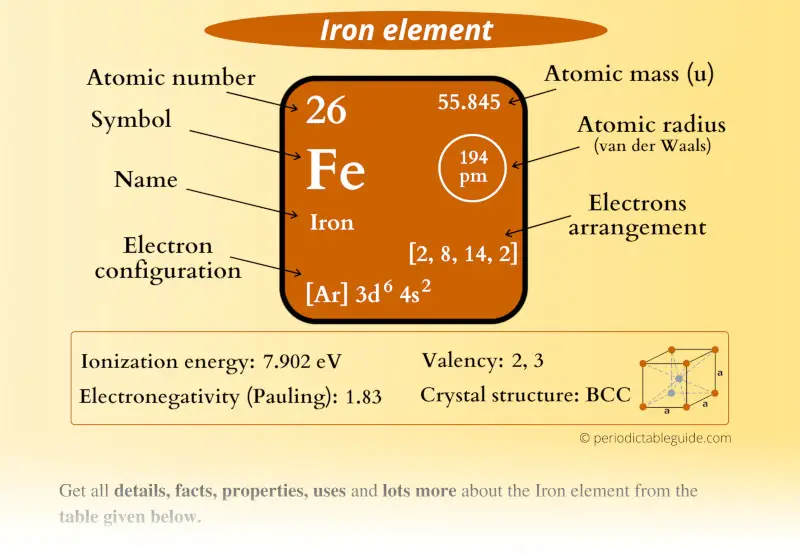
This is a SUPER easy guide on Iron element.
In fact, the table mentioned below is the perfect information box (Which gives you every single detail about the Iron element in Periodic table.)
So if you want to know anything about Iron element, then this guide is for you.
Let’s finish this very quickly.
Iron Element (Fe) Information
| Appearance | 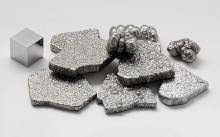 Lustrous metallic grey color |
| State (at STP) | Solid |
| Position in Periodic table | 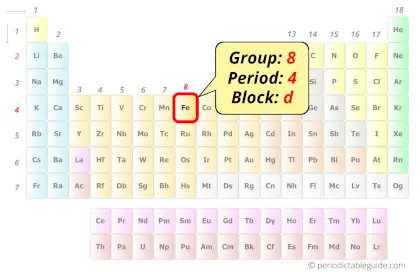 Group: 8, Period: 4, Block: d |
| Category | 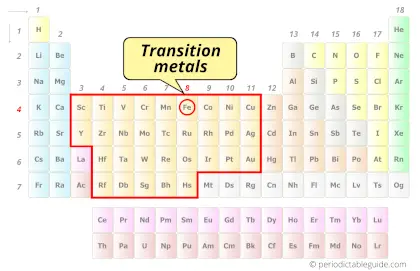 Transition metals |
| Atomic number or Protons | 26 |
| Neutrons | 30 |
| Electrons | 26 |
| Symbol | Fe |
| Atomic mass | 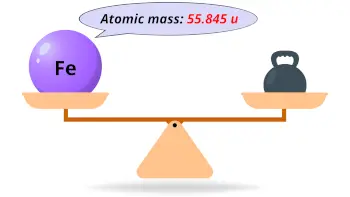 55.845 u |
| Electrons arrangement or Bohr model | 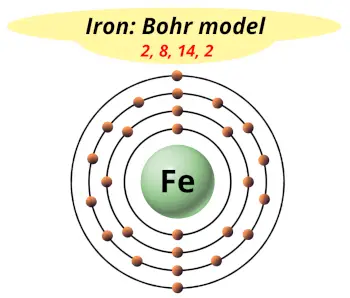 2, 8, 14, 2 |
| Electronic configuration | [Ar] 3d6 4s2 |
| Atomic radius | 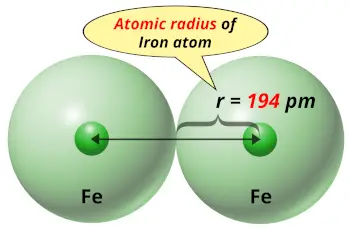 194 picometers (van der Waals radius) |
| 1st Ionization energy | 7.902 eV |
| Electronegativity | 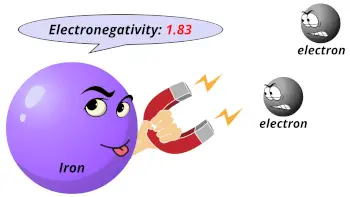 1.83 (Pauling scale) |
| Crystal structure | 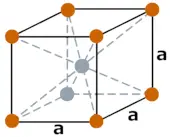 BCC (Body centered cubic) |
| Melting point | 1811 K or 1538 °C or 2800 °F |
| Boiling point | 3134 K or 2862 °C or 5182 °F |
| Density | 7.875 g/cm3 |
| Main isotope | 56Fe |
| When was Iron Discovered? | Before 5000 BC |
| CAS number | 7439-89-6 |
Iron in Periodic table
Iron element is in group 8 and period 4 of the Periodic table. Iron is the d-block element and it belongs to transition metals group.
| H | He | ||||||||||||||||
| Li | Be | B | C | N | O | F | Ne | ||||||||||
| Na | Mg | Al | Si | P | S | Cl | Ar | ||||||||||
| K | Ca | Sc | Ti | V | Cr | Mn | Fe | Co | Ni | Cu | Zn | Ga | Ge | As | Se | Br | Kr |
| Rb | Sr | Y | Zr | Nb | Mo | Tc | Ru | Rh | Pd | Ag | Cd | In | Sn | Sb | Te | I | Xe |
| Cs | Ba | La* | Hf | Ta | W | Re | Os | Ir | Pt | Au | Hg | Tl | Pb | Bi | Po | At | Rn |
| Fr | Ra | Ac** | Rf | Db | Sg | Bh | Hs | Mt | Ds | Rg | Cn | Nh | Fl | Mc | Lv | Ts | Og |
| *Ce | Pr | Nd | Pm | Sm | Eu | Gd | Tb | Dy | Ho | Er | Tm | Yb | Lu | ||||
| **Th | Pa | U | Np | Pu | Am | Cm | Bk | Cf | Es | Fm | Md | No | Lr |
←Move to: Manganese (Mn) element – Periodic Table
→Move to: Cobalt (Co) element – Periodic Table
Why is Iron in Period 4?
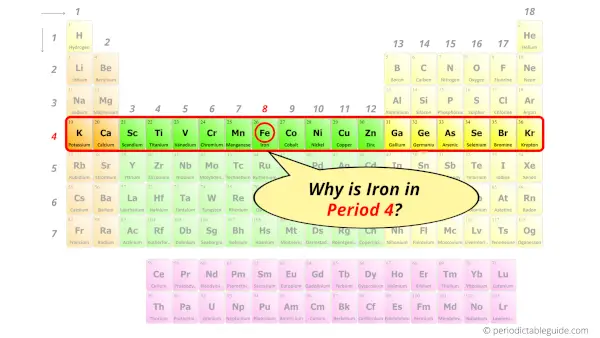
Let me ask you a question.
How many shells does iron have?
It’s 4. Right?
You have already seen the bohr model of iron atom in the above table.
From the Bohr model, it can be found that the number of orbits or shells in iron is 4. Hence, as iron has 4 orbits, it lies in period 4 of the Periodic table.
Why is Iron in d-block?
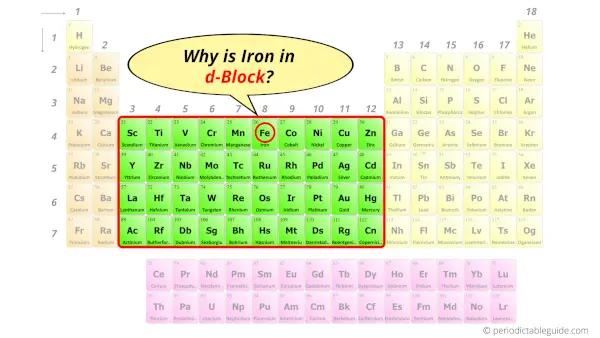
Before knowing this reason, first of all I want to ask you a simple question.
How can you determine the blocks-wise position of elements?
The simple answer: The elements will lie in the s, p, d or f block will completely depend upon the subshell in which the last electron will enter.
For example; the electron configuration of Iron is [Ar] 4s2 3d6.
So the last electron of Iron enters the d-subshell or d-orbital.
Hence, Iron is the d-block element.
Is Iron a Transition Metal? Why?
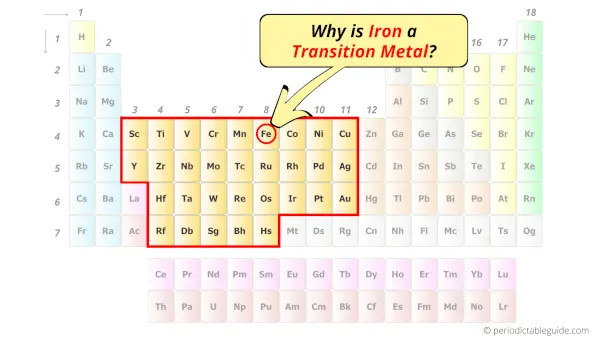
Yes, Iron is a transition metal because it has incompletely filled d-orbital in its ground state.
Let me explain the exact meaning of this.
According to the definition of transition metals;
The element should compulsorily have incomplete d-orbitals, either in their ground state (M) or most common oxidation states (M1+, M2+, etc) then only they are called transition metals.
Now, the ground state of Iron means its normal state in which it has neither gained nor lost any electron/s.
So the ground state of Iron is Fe.
And the ground state electronic configuration of Iron is [Ar] 4s2 3d6.
In this state, if we see the electron configuration of Iron, then it possesses incomplete d-orbitals.

Because, there are only six electrons in the d-orbitals.
In order to have the complete d-orbitals, there must be 10 electrons in it.
But in the ground state electronic configuration of iron, you can see that it has only 6 electrons in d-orbitals.
Thus, Iron has incomplete d-orbitals.
And hence, as Iron has incomplete d-orbitals, it is considered as a transition metal.
Also see: Location of transition metals on periodic table (Image)
9 Interesting facts about Iron
Interesting facts about Iron element are mentioned below.
- Iron is the 4th most abundant element (by weight) present in the earth’s crust.
- The outer core and the inner core of the earth contains most of the iron.
- Iron is also present in the sun, stars as well as meteors.
- According to some archaeologists, iron is the element that has been used by humans for more than 5000 years.
- Most of the iron produced nowadays is used in manufacturing of steels.
- Iron element is very essential for plants as well as animals. In plants, the iron element is used in production of chlorophyll and in animals and humans, the iron element is the component of hemoglobin (hemoglobin is a component of blood that carries pure oxygen from the lungs and transfers it to different organs of the body).
- The planet Mars looks reddish in color due to the presence of iron oxides on its surface.
- Iron is cheap, most abundant and the most used metal on the earth.
- China, Australia and Brazil are the 3 countries that mines most of the iron in the world.
Properties of Iron
The physical and chemical properties of Iron element are mentioned below.
Physical properties of Iron
Physical properties of Iron are mentioned below.
- Iron is a solid metal having a lustrous metallic grey color.
- The melting point of iron is 1538 °C and its boiling point is 2862 °C.
- Iron has many isotopes, but out of these isotopes 56Fe is most abundant (around 92%).
- Iron is a naturally occurring magnetic element on the earth.
- The iron atoms have a BCC (Body centered cubic) crystal structure.
Chemical properties of Iron
Chemical properties of Iron are mentioned below.
- Pure iron is fairly reactive and hence it is hardly found in a pure state. Most of the iron is found as a compound with other elements.
- The pure iron rapidly corrodes in the moist atmosphere, as iron reacts with oxygen and moisture of the air to form rust.
- Higher temperatures also result in corrosion of iron.
- The electron configuration of iron atoms shows incomplete d-orbitals, and because of this reason it is categorized as a transition metal according to IUPAC.
- The iron element burns with a golden colored flame in the flame test.
Uses of Iron
Uses of Iron are mentioned below.
- Iron is used to manufacture steels which are further used in construction work as well as other manufacturing works.
- The steel made of iron is also used in manufacturing of ships, cars, tools, etc.
- Iron and its alloys are also used to make magnets.
- Iron is also used in fireworks to produce sparks of different colors.
- Stainless steel (which contains iron and other alloying elements in it) has anticorrosive properties, so it is used in making kitchen utensils.
Explore our New Interactive Periodic Table (with Rotating Bohr Models and More)

Details about this Periodic table:
- Access detailed info on all elements: atomic mass, electron configurations, charges, and more.
- View rotating Bohr models for all 118 elements.
- Get a free HD image of the Periodic Table.
Note: For future use, bookmark this Periodic table or visit “PeriodicTableGuide.com”
External resources:
- A. (2019, February 1). For February, it’s iron — atomic No. 26. For February, It’s Iron — Atomic No. 26. https://www.asbmb.org/asbmb-today/science/020119/for-february-it-s-iron-atomic-no-26
- Iron – Element information, properties and uses | Periodic Table. (n.d.). Iron – Element Information, Properties and Uses | Periodic Table. https://www.rsc.org/periodic-table/element/26/iron
- Iron | Element, Occurrence, Uses, Properties, & Compounds. (n.d.). Encyclopedia Britannica. https://www.britannica.com/science/iron-chemical-element
- P. (n.d.). Iron | Fe (Element) – PubChem. Iron | Fe (Element) – PubChem. https://pubchem.ncbi.nlm.nih.gov/element/Iron
- It’s Elemental – The Element Iron. (n.d.). It’s Elemental – the Element Iron. https://education.jlab.org/itselemental/ele026.html
